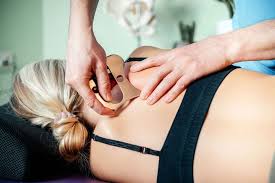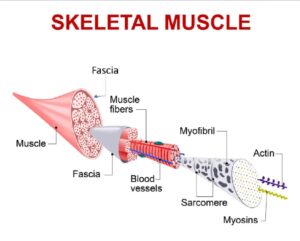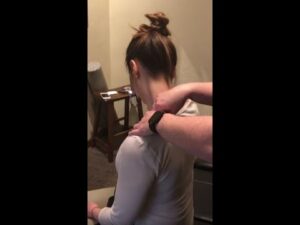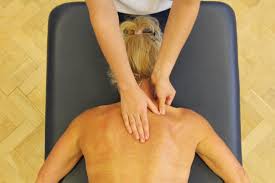

Posture is fundamental to physical health and well-being, yet many people struggle with poor posture due to prolonged sitting, lack of movement, or muscular imbalances.
Myofascial release has emerged as an effective technique to address these issues, offering a non-invasive way to improve alignment and correct postural dysfunctions.
BestForwardHeadPostureFix explores the role of myofascial release in posture correction, backed by scientific evidence and practical insights.
In This Article
- What Is Myofascial Release?
- Understanding Fascia and Its Role in Posture
- How Myofascial Restrictions Impact Posture
- Techniques of Myofascial Release for Posture Correction
- Scientific Evidence Supporting Myofascial Release
- Long-Term Benefits of Myofascial Release for Posture
- Steps to Incorporate Myofascial Release into a Routine
- Combining Myofascial Release with Other Posture Therapies
- Common Tools Used in Myofascial Release
- FAQs on How Myofacial Release Fixes Vulture Neck Posture
- Precautions and Best Practices for Myofascial Release
What Is Myofascial Release?
Myofascial release is a specialized hands-on technique designed to relieve tension and restrictions in the fascia—a connective tissue that encases and supports muscles, bones, and organs.
By applying gentle, sustained pressure to targeted areas, often referred to as “trigger points” or knots, this therapy restores the fascia’s natural elasticity and enhances mobility.
Unlike traditional massage, which typically focuses on muscle relaxation, myofascial release targets the deeper layers of tissue, making it particularly effective for correcting postural issues. Massage therapy to fix forward head really works wonders if performed correctly.
For example, consider someone who spends long hours at a desk. They might develop forward head posture and tightness in the upper back.
Through myofascial release, a therapist applies precise pressure to release restrictions in the thoracic and cervical fascia.
This helps realign the spine and improve overall posture.
As highlighted in a study published in the Journal of Bodywork and Movement Therapies, myofascial release is highly effective for reducing chronic tension and enhancing functional movement.
Understanding Fascia and Its Role in Posture
Fascia is like the body’s connective tissue glue, forming a web-like structure that provides support and stability.
When it is healthy, fascia is flexible and allows for smooth, pain-free movement. But life happens—injuries, stress, or repetitive strain can cause this delicate tissue to stiffen or adhere to surrounding muscles and joints, creating discomfort and imbalance.
A study in The Journal of Bodywork and Movement Therapies confirms that restricted fascia is often linked to muscular imbalances and poor posture. Imagine sitting hunched over your desk for hours—your fascia responds by tightening around overworked areas, like your shoulders and neck. Over time, this restricts mobility and worsens alignment.
Through myofascial release, a skilled therapist can gently apply sustained pressure to these tight spots, helping to restore the fascia’s pliability. This not only improves posture but also enhances ease of movement, making day-to-day activities more comfortable and enjoyable.
How Myofascial Restrictions Impact Posture?
Restricted fascia can significantly disrupt the musculoskeletal system, pulling the body out of its natural alignment. This tension often leads to postural issues, including:
- Forward Head Posture: Tight fascia in the upper back and neck pulls the head forward, creating strain on the cervical spine.
- Rounded Shoulders: Adhesions in the pectoral fascia promote slouched shoulders, often linked to prolonged desk work or poor ergonomics. Slouched shoulders increase brain fatigue – a fact most people tend to ignore.
- Pelvic Tilt: Tight fascia in the hip flexors and lower back contributes to anterior or posterior pelvic tilts, affecting overall spinal alignment.
- Kyphosis or Lordosis: Restricted fascia around the thoracic or lumbar spine can exacerbate excessive spinal curvatures, leading to discomfort and restricted mobility.
By addressing these restrictions, myofascial release can help restore proper alignment and reduce compensatory movements.
According to research in The Journal of Bodywork and Movement Therapies, releasing fascial tension enhances posture and mobility, alleviating pain and improving functional movement patterns.
Techniques of Myofascial Release for Posture Correction
Several effective techniques are available to release fascial tension and improve alignment:
- Manual Myofascial Release: A trained therapist applies sustained, gentle pressure to tight areas, helping to restore mobility in the fascia. This hands-on approach is particularly effective for addressing deep restrictions.
- Self-Myofascial Release: Tools such as foam rollers, lacrosse balls, and massage sticks enable individuals to independently target and release tight fascia. This technique is widely used for daily maintenance and prevention of stiffness.
- Active Release Therapy (ART): This technique combines focused pressure with specific, guided movements to break up fascial adhesions and improve range of motion.
- Instrument-Assisted Release: Precision tools, like Graston instruments, are used to apply targeted pressure to restricted fascia, promoting circulation and reducing tension.
Each method is tailored to specific fascial layers and areas of tension.
According to research in The Journal of Manual & Manipulative Therapy, combining these techniques addresses the root causes of postural issues and promotes long-term musculoskeletal health.
Scientific Evidence Supporting Myofascial Release
Scientific studies strongly support the benefits of myofascial release in correcting posture and alleviating related discomfort.
A 2022 study published in The International Journal of Sports Physical Therapy demonstrated that myofascial release significantly improved posture and reduced pain in individuals with forward head posture, a common issue caused by modern sedentary lifestyles.
Similarly, research in The Journal of Clinical Rehabilitation highlighted that myofascial release increased the range of motion and addressed muscular imbalances, key factors in maintaining proper posture.
Another study in The Journal of Bodywork and Movement Therapies emphasized that myofascial release enhances proprioception—the body’s awareness of its position and movement in space.
By improving proprioception, individuals are better able to maintain proper alignment during daily activities.
Additionally, the therapy was found to reduce fascial adhesions and tension, which are primary contributors to postural misalignment. These findings collectively underscore the role of myofascial release as a valuable intervention for posture correction.
Long-Term Benefits of Myofascial Release for Neck Posture
Consistent myofascial release provides a range of long-term benefits that positively impact both posture and overall well-being. By targeting restricted fascia, it helps restore the body’s natural alignment, reducing compensatory movements that contribute to chronic discomfort.
Improved alignment alleviates strain on muscles and joints, minimizing pain and reducing the likelihood of postural issues becoming severe.
Research published in The Journal of Sports Medicine and Physical Fitness highlights that releasing fascial tension enhances mobility by allowing smoother, more efficient movement.
This not only improves daily functionality but also boosts athletic performance. Additionally, loosening stiff fascia in the thoracic region facilitates better breathing mechanics, as optimal lung expansion becomes possible with improved posture.
These benefits are not limited to aesthetics or movement; they also enhance overall physical performance and quality of life.
By addressing underlying fascial restrictions, myofascial release becomes a powerful tool for long-term musculoskeletal health and well-being.
Steps to Incorporate Myofascial Release into a Routine
To maximize the benefits of myofascial release for posture correction, follow these simple yet effective steps:
- Identify Problem Areas: Pinpoint areas prone to tension, such as the neck, shoulders, lower back, and hips. These regions often contribute to postural imbalances.
- Choose the Right Tools: Use foam rollers for broad areas like the back or thighs. Opt for smaller tools like massage balls or sticks to target specific knots and trigger points.
- Apply Gentle Pressure: Maintain consistent pressure on tight spots for 30-60 seconds, or until you feel the tissue release. Avoid applying excessive force to prevent discomfort or injury.
- Combine with Stretching: Follow up myofascial release with targeted stretches to lengthen muscles and reinforce proper alignment.
- Be Consistent: Perform myofascial release 2-3 times weekly for lasting improvements. Regular practice helps maintain alignment and prevents the return of fascial tightness.
Research in The International Journal of Sports Therapy emphasizes the importance of combining release techniques with other mobility exercises to achieve optimal posture correction. Consistency and attention to form are key to unlocking the full benefits of this effective approach.
Combining Myofascial Release with Other Posture Therapies
While myofascial release works wonders, pairing it with other therapies can take your posture game to the next level. Think of it as a team effort—your fascia can’t do it alone!
- Postural Retraining: Simple exercises like chin tucks and scapular retractions are like the personal trainers for your posture. They strengthen the muscles that keep your head high and your shoulders back.
- Yoga and Pilates: These aren’t just trendy workout buzzwords. They boost flexibility, core strength, and body awareness, making you less likely to slouch. Hello, better posture and zen vibes!
- Ergonomic Adjustments: Your desk setup matters! Adjust your chair, monitor, and keyboard so they align with your posture goals. Less strain, more gains.
A holistic approach, blending myofascial release with these practices, creates a dream team for posture correction. As they say, a happy spine equals a happier you—and that’s a win!
Common Tools Used in Myofascial Release
Self-myofascial release becomes more effective with the right tools to address tension and improve posture. Here’s a breakdown of the most commonly used tools:
- Foam Rollers: These are great for large muscle groups like the back, thighs, and calves. They help reduce muscle tightness and improve circulation.
- Lacrosse Balls: Perfect for pinpointing smaller, harder-to-reach areas like the shoulders, glutes, or the base of the neck.
- Massage Sticks: These allow for more control and precision, making them ideal for targeting specific tension points, especially in the legs or forearms.
- Theracane or Trigger Point Tools: Designed for deep-tissue release, these tools are excellent for applying pressure to hard-to-reach spots, like knots in the upper back or along the spine.
Choosing the right tools ensures maximum relief and better results. By using these regularly, you can ease tension, promote mobility, and support a healthier, more aligned posture.
FAQs on How Myofacial Release Fixes Vulture Neck Posture
Q-1. How Does Myofascial Release Actually Help Correct Poor Posture?
A-1. Myofascial release (MFR) targets stiff, sticky layers of fascia that can limit joint motion and subtly “tug” your body out of ideal alignment. By easing fascial stiffness—especially around the thoracolumbar fascia in the lower back—MFR frees up movement so your spine and shoulder girdle can stack more naturally. People often notice immediate changes: easier upright sitting, smoother shoulder motion, and less pulling across the neck and mid-back, which makes good posture feel doable rather than forced.
Q-2. Is There Evidence That Myofascial Release Improves Forward Head Posture (FHP)?
A-2. Research increasingly points that way, particularly when MFR is paired with exercise. Trials have shown that adding MFR to neck and upper-back programs can reduce FHP and improve neck range. Fascial connections run across the rib cage and diaphragm, so releasing those areas can indirectly help the head and neck “re-center.” The practical takeaway: treat the whole chain, not just the sore spot.
Q-3. What Changes First—Pain, Range of Motion, Or Alignment?
A-3. Usually pain decreases and range of motion improves first. Once tissues feel less guarded and joints move more freely, alignment changes become easier and more sustainable. Think of MFR as the “unlock” that reduces tissue resistance; then your posture drills and daily habits act as the “save button” that helps your body keep the new position.
Q-4. Are There New Tools To Show Fascia Stiffness Is Linked To Posture Problems?
A-4. Yes. Modern ultrasound techniques (like shear-wave elastography) can measure tissue stiffness and have shown that people with chronic back or neck issues often have stiffer fascia. Clinicians use this information to guide care: if stiffness is high in a region that influences posture, targeted MFR plus mobility and strengthening can be prioritized to restore smoother movement and more efficient stacking.
Q-5. What’s The Most Effective Way To Use Myofascial Release For Posture—Alone Or With Exercise?
A-5. Combine it with smart training. Do brief MFR to “open” range—think 60–120 seconds per region—and then follow with technique-driven exercises: deep neck flexor activation, scapular retraction and upward rotation work, thoracic extension mobility, and diaphragmatic breathing. This pairing turns short-term relief into long-term change by teaching your nervous system to use the new range in real-world positions.
Quick usage tips: Keep pressure moderate (discomfort is okay, sharp or nerve-like pain is not). Breathe slowly while releasing; aim for consistency over intensity. Layer MFR before posture drills and ergonomic tweaks (screen height, chair setup, keyboard position). Expect quick comfort/ROM gains within sessions and visible posture improvements over weeks as practice compounds.
Precautions and Best Practices for Myofascial Release
While myofascial release is a widely effective and safe technique, taking precautions is essential to prevent discomfort or injury. Here are some key considerations:
- Avoid Overpressure: Excessive force can lead to bruising or tissue damage. Gentle, sustained pressure is more effective and safer for releasing tension.
- Consult a Professional: If you are new to myofascial release or unsure about techniques, seek guidance from a physical therapist. Proper instruction minimizes the risk of improper application.
- Avoid Inflammatory Areas: Never apply pressure to areas with active inflammation, open wounds, or recent injuries, as it can worsen the condition.
- Hydrate: Myofascial release can help release toxins stored in the tissues. Drinking plenty of water afterward aids in flushing out these toxins and promotes recovery.
By following these best practices, you can ensure a safe and effective myofascial release routine that supports posture correction and overall well-being.
Conclusion
Myofascial release is an effective and non-invasive technique for correcting posture by targeting fascial restrictions and muscular imbalances.
It works by releasing tension in the fascia, the connective tissue surrounding muscles and organs, to restore alignment and promote better mobility. This method is particularly beneficial for alleviating pain, enhancing flexibility, and addressing common postural issues like forward head posture and rounded shoulders.
Scientific studies, such as those published in The Journal of Bodywork and Movement Therapies, confirm the effectiveness of myofascial release in improving posture and overall physical health.
By integrating this technique into a regular wellness routine, individuals can experience significant improvements in movement, comfort, and alignment.
Combining myofascial release with complementary therapies such as stretching, postural exercises, and ergonomic adjustments further amplifies its benefits.
Consistency is key to achieving long-term results, making this technique a valuable tool for fostering a healthier, more aligned body.
References:



